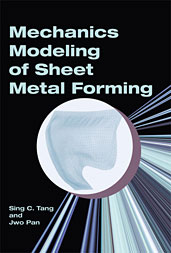Technical Paper
Failure Prediction of Sheet Metals Based on an Anisotropic Gurson Model
2000-03-06
2000-01-0766
A failure prediction methodology that can predict sheet metal failure under arbitrary deformation histories including rotating principal stretch directions and bending/unbending with consideration of damage evolution is reviewed in this paper. An anisotropic Gurson yield criterion is adopted to characterize the effects of microvoids on the load carrying capacity of sheet metals where Hill’s quadratic anisotropic yield criterion is used to describe the matrix normal anisotropy and planar isotropy. The evolution of the void damage is based on the growth, nucleation and coalescence of microvoids. Mroz’s anisotropic hardening rule, which was proposed based on the cyclic plastic behavior of metals observed in experiments, is generalized to characterize the anisotropic hardening behavior due to loading/unloading with consideration of the evolution of void volume fraction. The effects of yield surface curvature are also included in the plasticity model.

